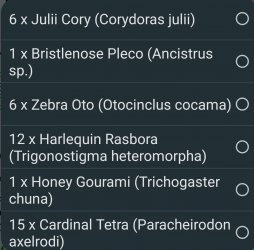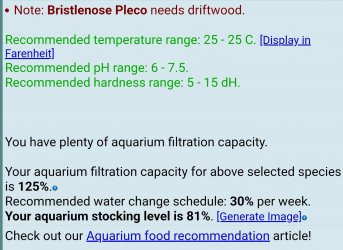FISHnLAB
New Member
Hi guys, nice to meet you . This is my first post on the forum.
. This is my first post on the forum.
So, I am a rookie fish keeper(less then 6 weeks) who has never grown aquatic plants and am currently planning my first planted community tank and could use some advice from the experienced please. Here are the build details so far...
Tank - 45 Gallon Marineland(PetSmart) or Standard 40 Gallon Breeder.
Tank Light - 2 x Hygger 957(36 - 48") or 1 x Fluval Plant 3.0(36-48").
Filter - Fluval 307 & a 20 - 40 gallon spounge filter with airstone insert.
Heater - 2 x Eheim Jager 200 Watt.
Temperature Controller - Inkbird 306A
Timer - Globe Electric 50151 WIFI
UV Filter - Fluval Inline UVC Clarifier on output of canister.
#Will add a power head if needed once build is complete.
#might add CO2 as well but, want to learn the low tech game first.
Pictures added with my planned fish load. I used AQAdvisor and 45 gallon for the tank size...
I am still planning my aquascape but, it will likely be heavily planted with larger rocks, mopani driftwood, and dark grey small pebble or coarse sand substrate and light grey river rock dusted on top for aesthetics. I will use a layer of some type of aquasoil underneath with root tabs(NilocG) dispersed within inside of nylon mesh bags for easy cleanup. Fertilizer will most likely be NilocG's ThriveC with periodic ThriveCaps Root Tab replacement.
So, what do you guys think of everything? Any questions? Any constructive criticisms? Any suggestions? Any advice? I am very new to the hobby so any input is more then welcome and appreciated. Thank you very much in advance .
.
Edit: I will be using Tap Water treated with Seachem Prime and here are my water parameters pre-treatment...
pH - 7.8
NH3 - 0
NO2 - 0
NO3 - 0
PO4 - 0
TDS - 44ppm
GH - 89.5ppm
KH - 71.6ppm
Also, the tank will be pre-cycled and I will learn to grow the plants successfully before adding fish.
So, I am a rookie fish keeper(less then 6 weeks) who has never grown aquatic plants and am currently planning my first planted community tank and could use some advice from the experienced please. Here are the build details so far...
Tank - 45 Gallon Marineland(PetSmart) or Standard 40 Gallon Breeder.
Tank Light - 2 x Hygger 957(36 - 48") or 1 x Fluval Plant 3.0(36-48").
Filter - Fluval 307 & a 20 - 40 gallon spounge filter with airstone insert.
Heater - 2 x Eheim Jager 200 Watt.
Temperature Controller - Inkbird 306A
Timer - Globe Electric 50151 WIFI
UV Filter - Fluval Inline UVC Clarifier on output of canister.
#Will add a power head if needed once build is complete.
#might add CO2 as well but, want to learn the low tech game first.
Pictures added with my planned fish load. I used AQAdvisor and 45 gallon for the tank size...
I am still planning my aquascape but, it will likely be heavily planted with larger rocks, mopani driftwood, and dark grey small pebble or coarse sand substrate and light grey river rock dusted on top for aesthetics. I will use a layer of some type of aquasoil underneath with root tabs(NilocG) dispersed within inside of nylon mesh bags for easy cleanup. Fertilizer will most likely be NilocG's ThriveC with periodic ThriveCaps Root Tab replacement.
So, what do you guys think of everything? Any questions? Any constructive criticisms? Any suggestions? Any advice? I am very new to the hobby so any input is more then welcome and appreciated. Thank you very much in advance
Edit: I will be using Tap Water treated with Seachem Prime and here are my water parameters pre-treatment...
pH - 7.8
NH3 - 0
NO2 - 0
NO3 - 0
PO4 - 0
TDS - 44ppm
GH - 89.5ppm
KH - 71.6ppm
Also, the tank will be pre-cycled and I will learn to grow the plants successfully before adding fish.
Attachments
Last edited:




